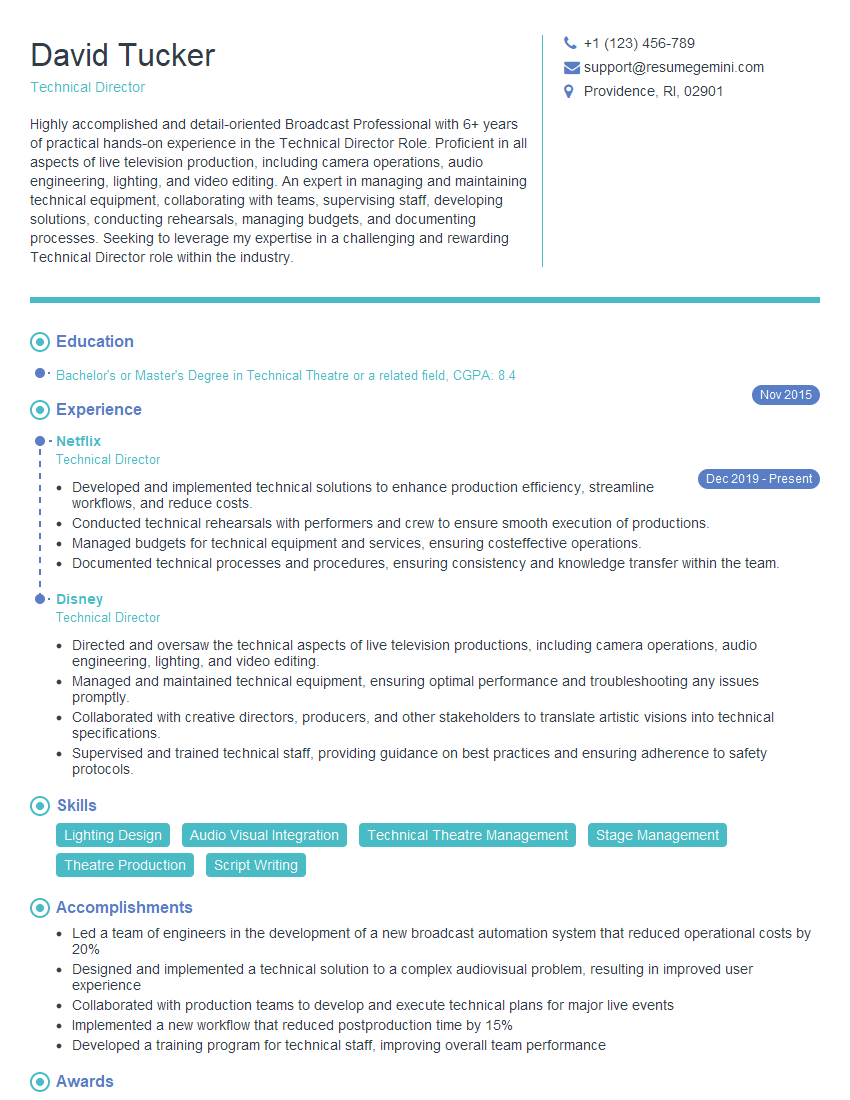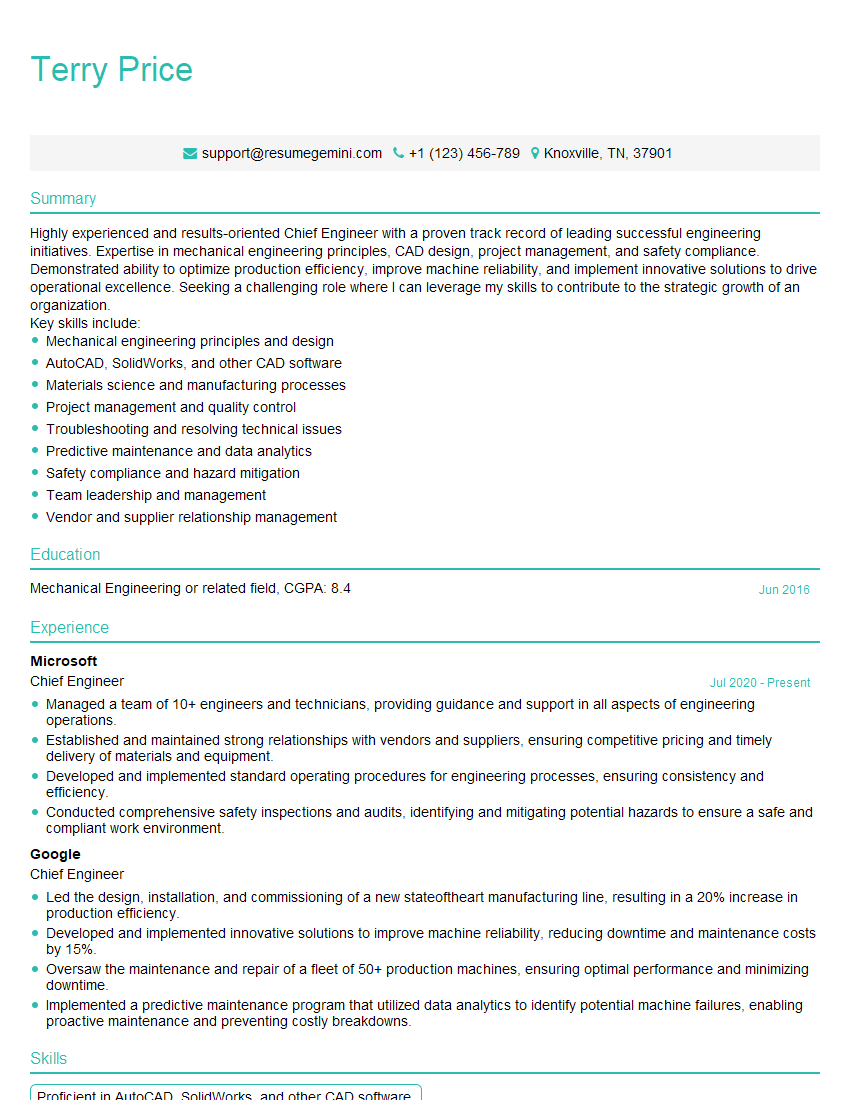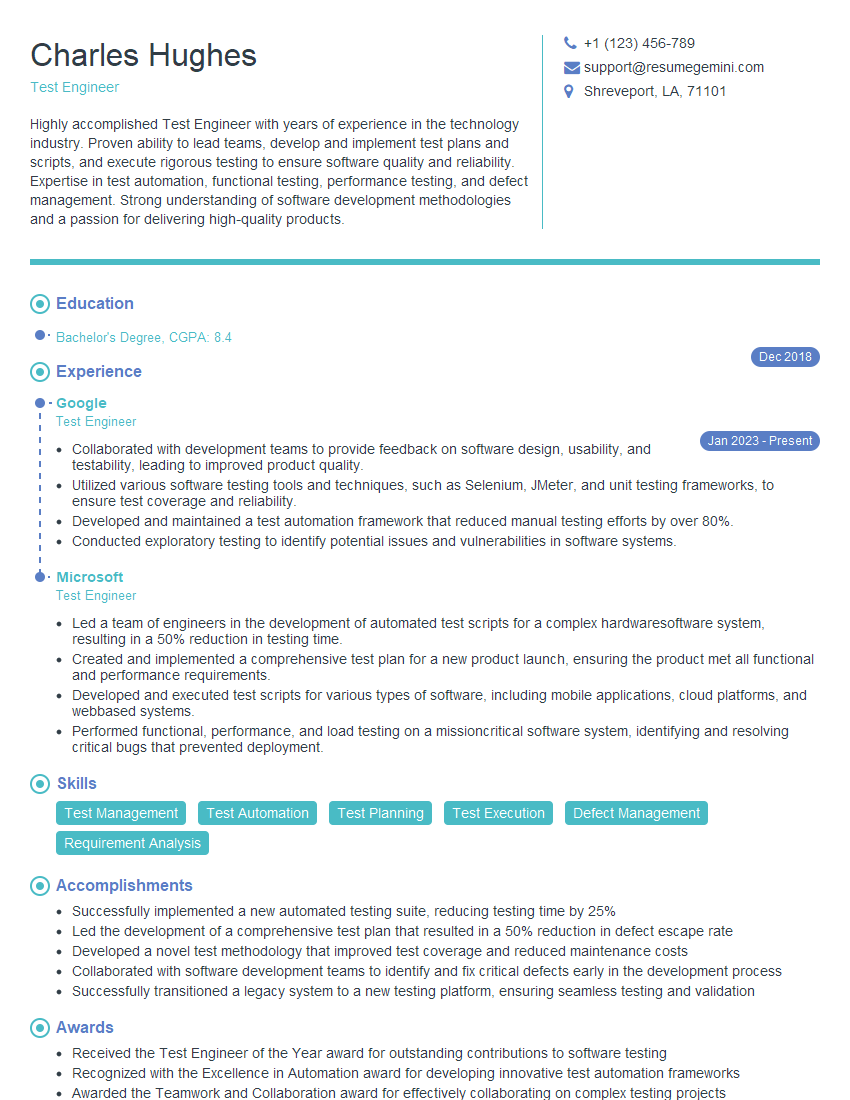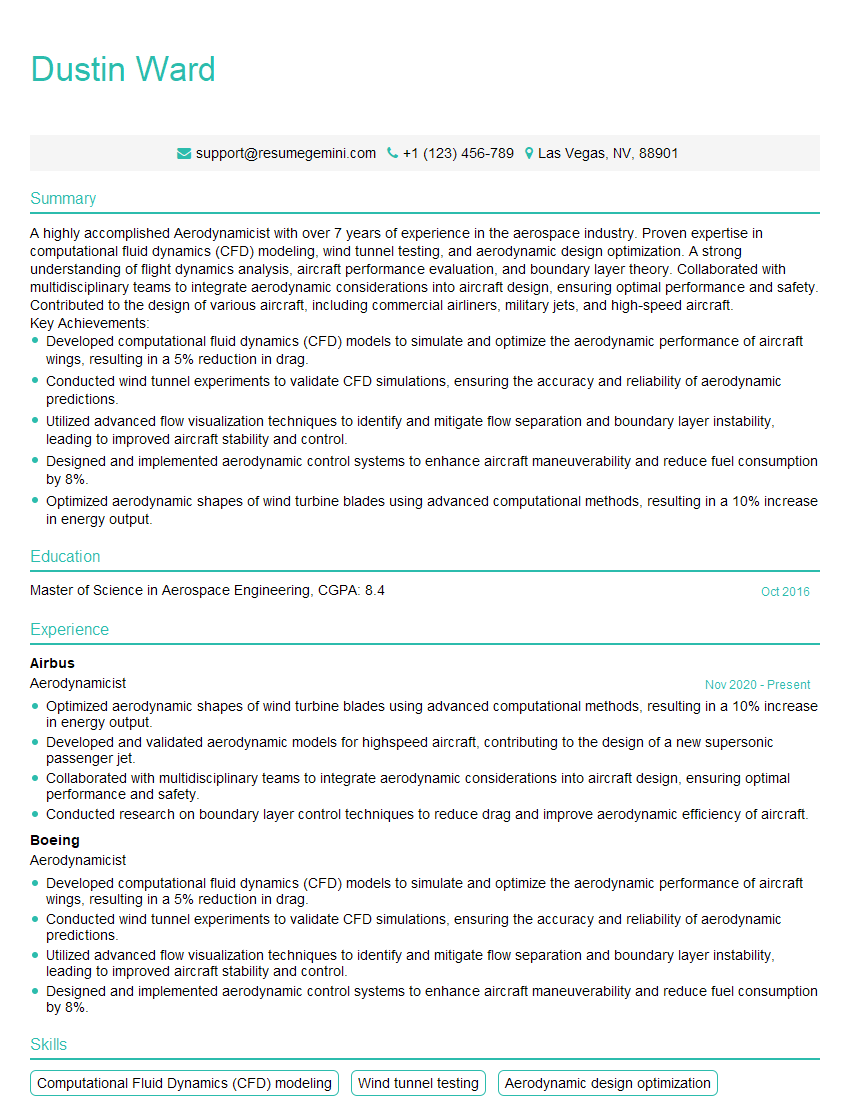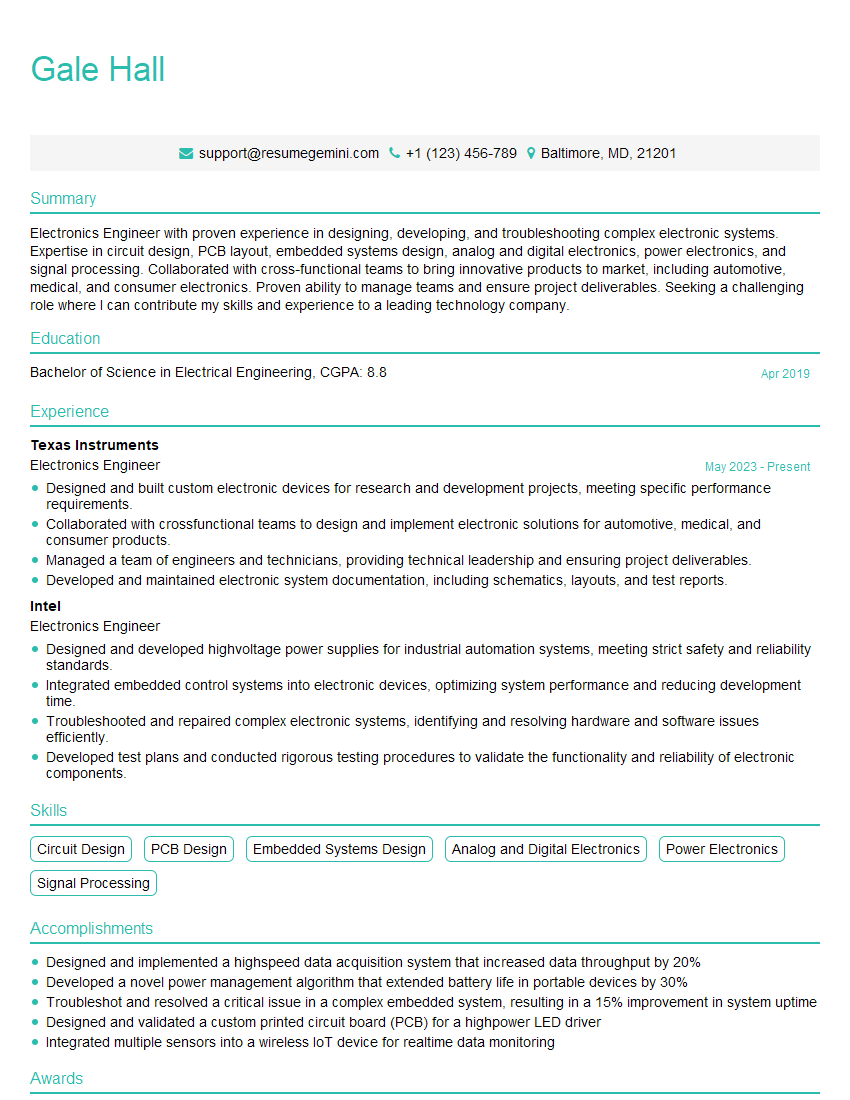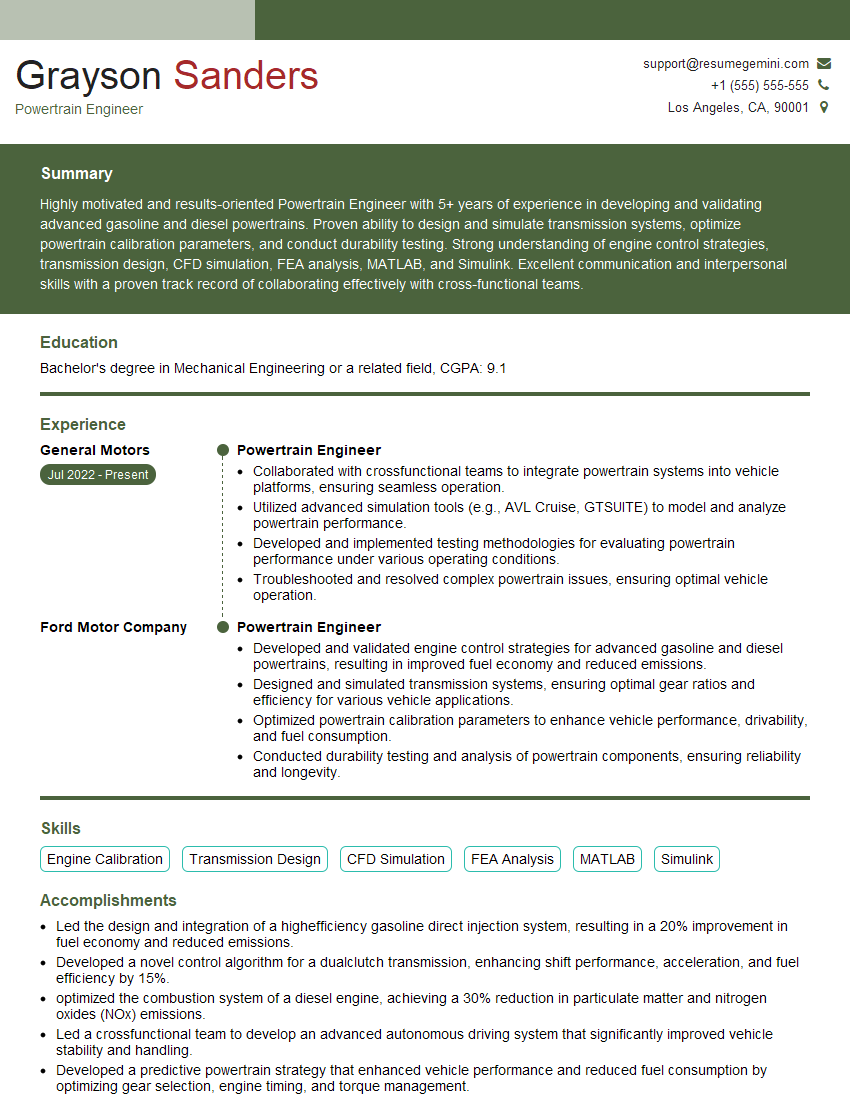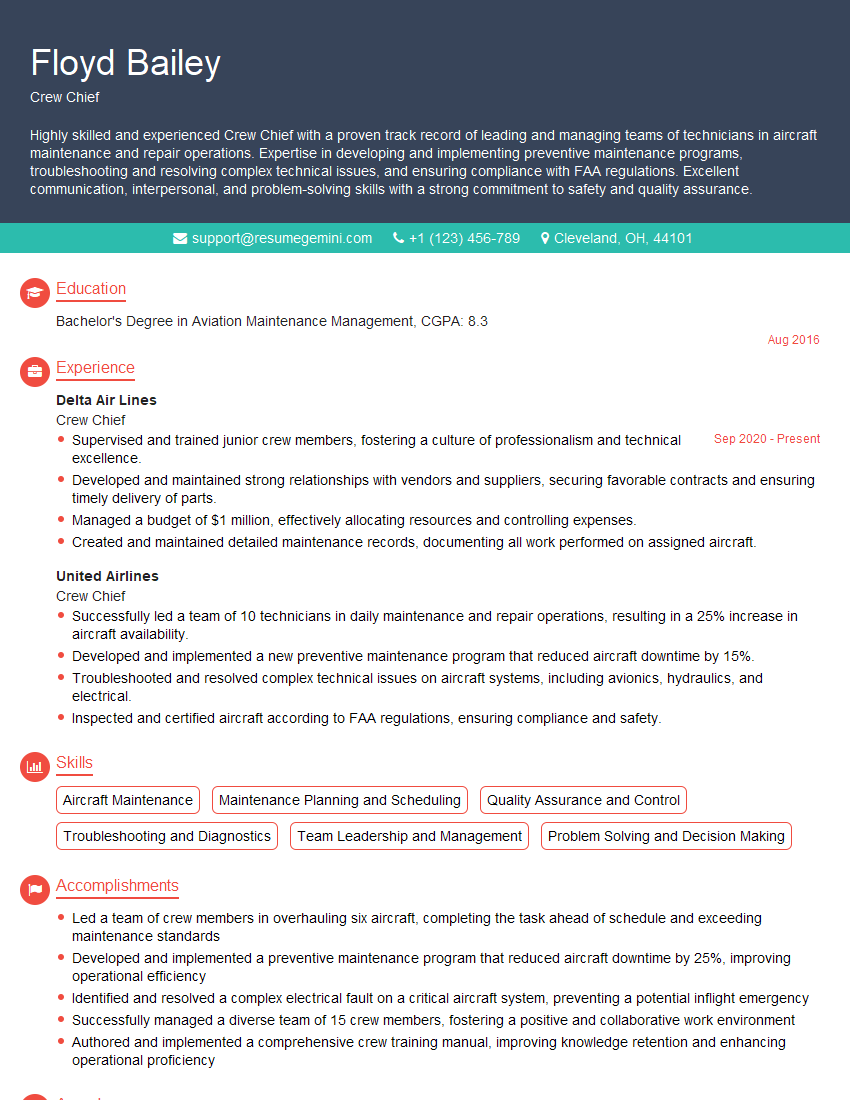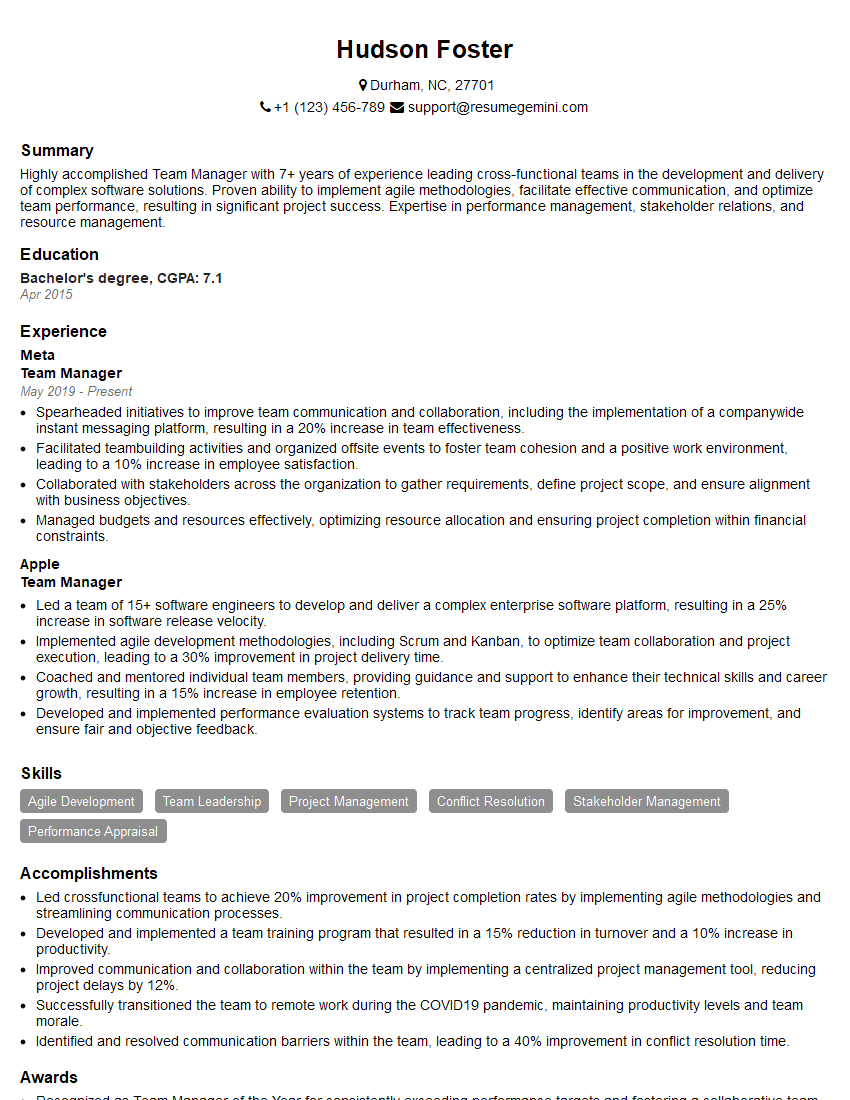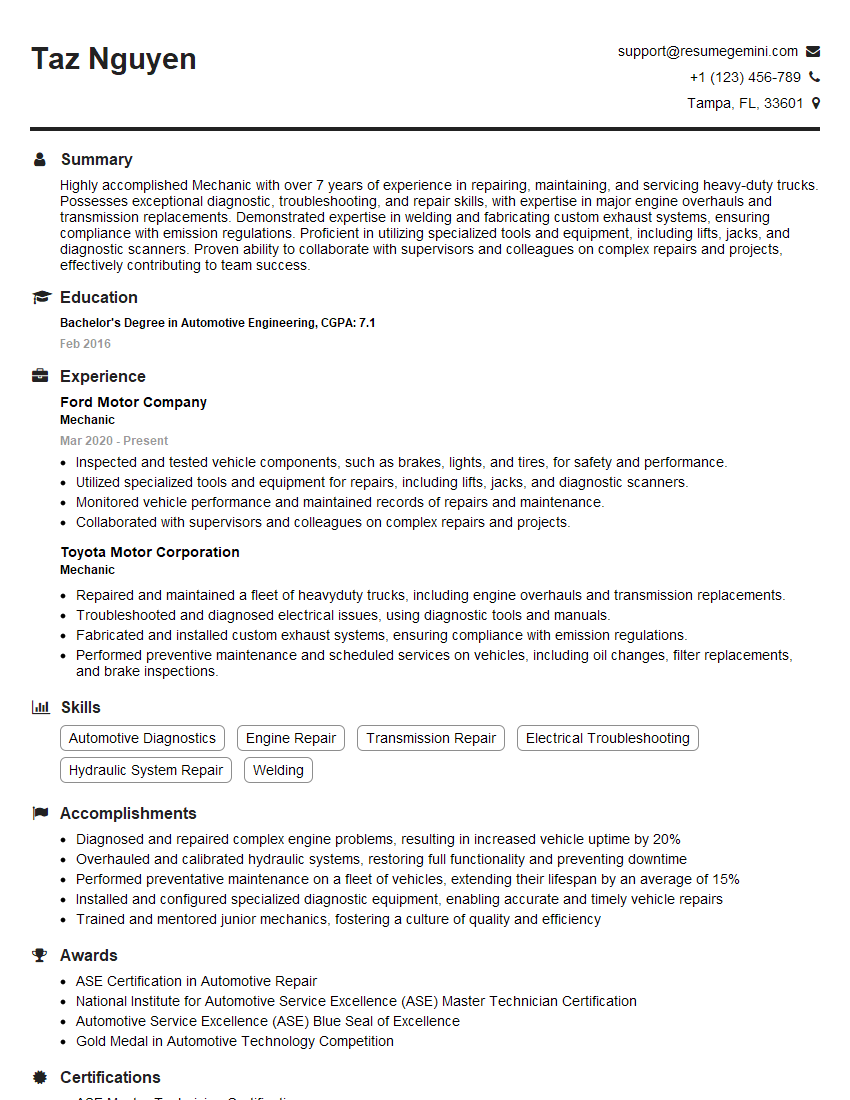Interviews are opportunities to demonstrate your expertise, and this guide is here to help you shine. Explore the essential Motorsport Industry Knowledge and Trends interview questions that employers frequently ask, paired with strategies for crafting responses that set you apart from the competition.
Questions Asked in Motorsport Industry Knowledge and Trends Interview
Q 1. Explain the aerodynamic principles behind downforce generation.
Downforce is the aerodynamic force that pushes a race car downwards, increasing its grip on the track. It’s generated primarily through carefully designed aerodynamic components that manipulate airflow. Think of an airplane wing, but inverted. Instead of lifting, these components create a pressure difference above and below, resulting in a net downward force.
This pressure difference is achieved by shaping the components to accelerate airflow over the top surface. According to Bernoulli’s principle, faster-moving air exerts lower pressure. The faster airflow over the top surface creates a lower pressure zone compared to the higher-pressure zone underneath. This pressure differential generates the downforce.
- Wings (or spoilers): These are the most prominent downforce generators, with angled surfaces creating a pressure difference. Their angle and shape are crucial for balancing downforce and drag.
- Diffusers: Located at the rear of the car, diffusers accelerate the airflow exiting the underside, reducing pressure and increasing downforce. They work by gradually widening the airflow path, converting velocity into pressure.
- Underbody aerodynamics: The smooth underbody and carefully sculpted floor panels help to channel airflow efficiently and contribute to downforce generation. The goal is to minimize disruption and maintain the pressure differential.
For instance, Formula 1 cars generate massive downforce, allowing them to corner at incredibly high speeds. The design of their wings, diffusers, and underbody is constantly refined to optimize downforce, providing superior handling and speed.
Q 2. Describe the different types of suspension systems used in motorsport.
Motorsport employs various suspension systems, each with strengths and weaknesses depending on the track and racing style. The primary goal is to maintain tire contact with the track surface for optimal grip and control.
- Double Wishbone: This system uses two wishbones (A-arms) to locate the wheel, offering excellent control over camber, caster, and toe. It’s highly adjustable and commonly found in Formula 1 and other high-performance categories. Think of it as a very precise and adjustable way to locate the wheel.
- MacPherson Strut: A simpler and more compact system that integrates the spring and damper into a single unit, it is cost-effective and commonly used in touring cars and less demanding categories. While less adjustable than double wishbone, it’s easier to package.
- Pushrod and Pullrod: These systems use a rod to connect the damper and spring to the chassis, with pushrod systems pushing the damper and pullrod systems pulling it. This offers excellent control and packaging flexibility, frequently seen in top-level motorsport.
- Inboard Suspension: The suspension components are mounted inside the chassis, improving aerodynamics by reducing the number of components exposed to the airflow. This setup is typically found on higher-end race cars where aerodynamic efficiency is critical.
The choice of suspension system involves compromises. Double wishbone offers superior adjustability but is complex and expensive, whereas MacPherson strut is simpler but less sophisticated. The ideal choice depends on the vehicle’s performance goals and cost limitations.
Q 3. What are the key factors influencing tire selection and strategy?
Tire selection and strategy are paramount in motorsport, directly impacting performance and race outcome. The key factors are:
- Track Conditions: The grip level of the track surface is crucial. Wet, dry, or damp conditions require different tire compounds with varying levels of grip and water-dispersing capabilities.
- Temperature: Tire performance is heavily influenced by temperature. Different compounds have optimal operating temperature ranges. Track and ambient temperatures dictate tire selection to maintain peak performance.
- Tire Compound: Each compound offers a different balance between grip, durability, and degradation rate (how quickly the tire wears out). Softer compounds provide higher grip but wear out faster, while harder compounds offer better durability but less grip.
- Race Strategy: Tire life and performance degradation inform the pit stop strategy. A longer stint (time between pit stops) might be chosen to save time or use a more durable compound, while shorter stints could prioritize maximizing grip throughout the race.
For example, a Formula 1 team meticulously analyses weather forecasts and track temperature to select the optimal tire compounds before the race and dynamically adjust their pit strategy based on tire wear and track evolution throughout the race. This strategic decision-making heavily influences the final race outcome.
Q 4. How does telemetry data inform race strategy decisions?
Telemetry data is the lifeblood of modern motorsport, providing real-time information about the car’s performance and the driver’s actions. This data informs crucial strategic decisions.
Sensors throughout the car transmit data such as speed, acceleration, braking force, tire temperatures, engine parameters, and aerodynamic pressures. This data, visualized in real time and analyzed post-race, helps optimize performance.
- Tire Management: Telemetry shows tire temperatures and pressures, enabling proactive adjustments of driving style to optimize tire life and maximize grip.
- Fuel Strategy: Real-time fuel consumption data helps determine the optimal fuel load and pit stop strategy for achieving the best race outcome.
- Setup Optimization: Analysis of suspension behavior, aerodynamic loads, and other parameters allows engineers to fine-tune the car’s setup for specific track conditions and driving styles.
- Driver Performance: Telemetry data can reveal areas for driver improvement in terms of braking, acceleration, and cornering technique, leading to more consistent and faster lap times.
For instance, if telemetry reveals excessive tire wear on the rear right tire, the team can advise the driver to adjust their driving style to reduce load on that tire or adjust the car’s setup to improve tire life. This real-time feedback allows for rapid response to changing conditions and maximizes performance.
Q 5. Explain the role of data acquisition and analysis in motorsport.
Data acquisition (DAQ) and analysis are integral to modern motorsport. DAQ systems collect vast amounts of sensor data from the car, while analysis tools process this information to provide insights for improvement.
Data is collected using various sensors measuring everything from engine parameters and aerodynamic forces to suspension movements and tire temperatures. Specialized software then processes, stores, and analyzes this data.
- Performance Optimization: Identifying areas for improvement in vehicle dynamics, engine performance, and driver technique.
- Fault Diagnosis: Quickly diagnosing and addressing mechanical issues during testing or races.
- Simulation and Modeling: Creating accurate simulations of vehicle performance to improve design and development.
- Competitive Advantage: Extracting valuable insights from the data can provide a significant competitive edge.
A team might discover, through data analysis, that a specific corner is causing excessive tire wear due to oversteering. They could then modify the car’s setup, adjust driver inputs, or even redesign the aerodynamics to mitigate the problem, resulting in improved lap times and performance.
Q 6. Describe the process of developing and validating a new motorsport component.
Developing and validating a new motorsport component is a rigorous process involving multiple stages.
The process typically begins with design and simulation using computational fluid dynamics (CFD) for aerodynamics and finite element analysis (FEA) for structural integrity. Prototypes are then manufactured and tested in a controlled environment (wind tunnel, dynamometer, etc.).
- Design and Simulation: Using CAD software and simulations to optimize the component’s performance and durability.
- Manufacturing and Assembly: Producing prototypes using appropriate manufacturing techniques (e.g., 3D printing, CNC machining).
- Testing and Validation: Rigorous testing under realistic conditions using data acquisition to assess performance and durability.
- Iteration and Refinement: Analyzing test results to identify weaknesses and areas for improvement, iteratively refining the design and testing further.
- Validation and Qualification: Once performance and durability targets are met, the component is validated and qualified for race use. This might involve further testing under race conditions, often using a test driver.
For instance, developing a new front wing requires extensive wind tunnel testing to optimize aerodynamic performance, ensuring sufficient downforce without excessive drag. Then, on-track testing verifies that the wing performs as expected under real-world conditions. If issues are found, the design is iteratively refined and tested until it meets performance standards.
Q 7. What are the current trends in motorsport engine technology?
Current trends in motorsport engine technology focus on efficiency, sustainability, and performance enhancements.
- Hybrid Powertrains: The increasing use of hybrid systems combining internal combustion engines (ICE) with electric motors to improve efficiency and power output. Formula 1 is a prime example.
- Sustainable Fuels: A shift towards sustainable and renewable fuels such as biofuels and synthetic fuels to reduce emissions and environmental impact.
- Advanced Materials: The use of lightweight and high-strength materials such as carbon fiber composites to reduce weight and improve performance.
- Improved Combustion Efficiency: Continuous advancements in engine design and combustion strategies to improve fuel efficiency and power output.
- Increased Electrification: A gradual transition towards fully electric powertrains in lower-emission categories.
For example, Formula 1 is actively researching and implementing sustainable fuel technologies, alongside ever-improving hybrid powertrain efficiency. Other racing series are exploring fully electric powertrains, leading to a more sustainable and environmentally friendly motorsport landscape.
Q 8. Discuss the impact of hybrid powertrains in Formula 1.
The introduction of hybrid powertrains in Formula 1 has revolutionized the sport, pushing technological boundaries and promoting sustainability. These power units, combining internal combustion engines (ICE) with sophisticated energy recovery systems (ERS), are far more complex than their predecessors. The ERS, comprising the Motor Generator Unit-Kinetic (MGU-K) recovering energy during braking and the Motor Generator Unit-Heat (MGU-H) harvesting waste heat from the exhaust, adds a strategic layer to racing.
The impact is multifaceted. Firstly, it has significantly increased the complexity of the car, demanding advanced engineering and sophisticated software controls. Teams must optimize the interplay between the ICE and ERS to maximize performance, balancing power deployment with energy management for optimal lap times. Secondly, the hybrid element has introduced a new dimension of strategic decision-making during races. Drivers must carefully manage their energy reserves, deciding when to deploy the ERS for overtaking maneuvers or to maintain a defensive position. This requires a deep understanding of the track, weather conditions, and the performance of rival cars.
Finally, the adoption of hybrid technology in F1 serves as a powerful platform for technological advancement that trickles down to road cars. Innovations developed for the extreme demands of F1 often find their way into production vehicles, enhancing fuel efficiency and performance. The success of the hybrid power units in F1 showcases the feasibility and benefits of sustainable performance technologies.
Q 9. How do you manage the complexities of a pit stop?
Managing the complexities of a pit stop requires meticulous planning, precision execution, and seamless teamwork. Think of it like a highly choreographed dance, where every movement is crucial. A typical pit stop involves a team of highly trained mechanics working in perfect synchronicity to change tires, refuel the car, and potentially make other adjustments in under three seconds!
The process begins long before the car even enters the pit lane. The team anticipates the driver’s needs, considering tire wear, fuel levels, and potential car setup adjustments. Pre-race simulations and practice sessions are critical in refining the pit stop procedure, ensuring every action is practiced to perfection. During the stop itself, communication is paramount. Precise radio communication between the pit crew chief and the driver ensures the car stops in the correct position. The crew chief then guides the team, coordinating tire changes, refueling, and any necessary repairs with military precision. Post-pit stop analysis examines every detail, identifying areas for improvement and ensuring future pit stops are even faster and smoother. Advanced technology such as pneumatic tools and automated systems streamline the process, minimizing the time needed for each operation.
Q 10. Explain different fuel strategies used during a race.
Fuel strategy in motorsport is a crucial element determining race outcome. It’s a complex balancing act between maximizing performance and ensuring you have enough fuel to reach the finish line. Teams employ various strategies depending on race conditions, car performance, and competitor’s positions.
A common approach is a two-stop strategy, where the car makes two pit stops for fuel and tires. This allows for a more aggressive race pace early on, as drivers don’t have to conserve fuel as much, but requires careful calculation to make sure the pit stops don’t cost too much time. A one-stop strategy is a more conservative approach, where the car runs on a single fuel load for the entire race. It’s favored when fuel conservation is paramount or when tire degradation is minimal. Sometimes, teams employ a flexible strategy, adapting their approach based on unfolding events during the race like safety cars or changing weather conditions. These decisions require sophisticated modeling and real-time data analysis. For example, the team may opt to run a longer first stint if safety cars increase the race length, allowing them to make a shorter final stint without running out of fuel.
Factors considered include track characteristics, tire degradation rates, weather forecasts, and competitor strategies. Sophisticated simulation tools are used to predict fuel consumption under various race scenarios and optimize fuel loads to provide the best balance between speed and fuel efficiency.
Q 11. What are the latest advancements in motorsport simulation technology?
Motorsport simulation technology has undergone a dramatic evolution. Modern simulations are incredibly powerful tools, enabling teams to virtually test and develop cars and race strategies with unparalleled accuracy. This reduces the need for extensive and costly real-world testing.
Advancements include highly realistic driving simulators replicating real-world track conditions with immense detail. These simulators incorporate sophisticated physics engines that accurately model aerodynamics, tire behavior, and vehicle dynamics. Teams use these to evaluate car setups, test driver performance and explore various race strategies. Furthermore, computational fluid dynamics (CFD) software is used for detailed aerodynamic analysis, allowing engineers to optimize the car’s shape for minimal drag and maximum downforce. Machine learning algorithms are increasingly employed to analyze vast amounts of data from simulations and real-world testing, identifying optimal car setups and predicting race outcomes more accurately. This means that testing for car setups can occur before the actual event, making changes faster.
Q 12. How do you ensure compliance with motorsport regulations?
Ensuring compliance with motorsport regulations is a critical aspect of competing professionally. It’s not just about adhering to the rules; it’s about maintaining the integrity and fairness of the sport. Strict regulations govern every aspect of the car, from its design and construction to its performance and technical specifications.
The process involves a multi-layered approach. Firstly, teams work closely with governing bodies like the FIA (Fédération Internationale de l’Automobile) to interpret and understand the rules. This includes regular communication and clarification of ambiguous points. Secondly, meticulous documentation of design and testing processes is maintained. Every aspect of the car’s development is recorded and made available for inspection by scrutineers at the races. Teams employ dedicated technical personnel to ensure adherence to regulations. These individuals are responsible for monitoring compliance at all stages, from design to manufacturing and during the race weekends. The teams have to present to the FIA on technical aspects, during the design and development, and during the race. The FIA also carries out their own independent inspection and testing.
Any breach of regulations can result in penalties, ranging from fines to disqualification. This underscores the importance of strict adherence and the role of meticulous attention to detail in maintaining the integrity and sporting spirit of the competition.
Q 13. Describe the process of conducting a post-race analysis.
Post-race analysis is a critical process in motorsport, providing valuable insights to improve future performance. It’s a systematic review of all aspects of the race, identifying areas of strength and weakness, allowing for data-driven improvements.
The process typically involves several stages. First, teams review telemetry data from the car, including speed, acceleration, braking performance, and various sensor readings. This data provides a detailed picture of the car’s performance throughout the race. Next, engineers analyze the car’s performance, looking at tire wear, fuel consumption, aerodynamic efficiency, and the efficiency of the power unit. Driver feedback is incorporated, providing valuable insights into the car’s handling characteristics and areas for improvement. Lastly, all the collected data is combined, with the aim of identifying areas needing improvement and to develop solutions. These might include modifications to car setups, adjustments to race strategies or driver training exercises. By taking this systematic approach, teams can continuously refine car performance and race strategies for future events.
Q 14. What is the importance of driver feedback in vehicle development?
Driver feedback is invaluable in vehicle development. While sophisticated engineering tools provide objective data, drivers provide subjective insights that cannot be replicated through simulations alone. Their expertise is crucial in making the car both fast and manageable.
Drivers are uniquely positioned to feel and interpret the car’s behavior under various conditions. They can provide detailed feedback on areas like handling balance, braking performance, and tire grip, which might not be immediately apparent from data alone. For example, a driver might notice a subtle understeer condition that isn’t reflected in the telemetry, or might describe a vibration not captured by sensors. This qualitative data is vital in fine-tuning the car’s setup for optimal performance and driver comfort. The feedback loop between driver and engineering team is iterative. The engineers use driver feedback to make modifications, and the driver then evaluates the changes on the track providing continuous refinement until an optimal setup is achieved. This collaborative process significantly enhances the car’s performance and the driver’s confidence.
Q 15. How do you prioritize tasks under pressure during a race weekend?
Prioritizing tasks during a frantic race weekend requires a structured approach. It’s not just about speed, but efficient allocation of resources and expertise. I use a combination of techniques: First, a clear understanding of the critical path – what absolutely *must* be done to get the car on the grid and performing optimally. Then, I employ a prioritization matrix, considering urgency and impact. High urgency, high impact tasks (like a critical engine repair) take precedence over low urgency, low impact ones (like minor aesthetic adjustments). Finally, I delegate effectively, empowering my team to handle tasks within their expertise, ensuring clear communication and timelines. This ensures we tackle the most important issues first, avoiding critical failures and maximizing our chances of success. For example, during a qualifying session, ensuring the car is optimally fueled and set-up for the track conditions trumps detailed data analysis which can wait until post-session.
Career Expert Tips:
- Ace those interviews! Prepare effectively by reviewing the Top 50 Most Common Interview Questions on ResumeGemini.
- Navigate your job search with confidence! Explore a wide range of Career Tips on ResumeGemini. Learn about common challenges and recommendations to overcome them.
- Craft the perfect resume! Master the Art of Resume Writing with ResumeGemini’s guide. Showcase your unique qualifications and achievements effectively.
- Don’t miss out on holiday savings! Build your dream resume with ResumeGemini’s ATS optimized templates.
Q 16. Explain your understanding of CFD (Computational Fluid Dynamics) in motorsport.
Computational Fluid Dynamics (CFD) is a powerful simulation tool in motorsport, used to model and analyze airflow around a car. It helps engineers understand and optimize aerodynamic performance, which is crucial for speed, downforce, and overall handling. Essentially, CFD breaks down the complex flow of air into millions of tiny computational cells, applying the Navier-Stokes equations to predict air pressure, velocity, and turbulence at each point. This allows us to visualize airflow patterns, identify areas of high drag or separation, and test design modifications virtually before building a physical prototype. For instance, CFD can help determine the optimal shape of a wing, the positioning of aerodynamic elements like diffusers and splitters, or the effectiveness of various bodywork configurations. The results are then used to refine the car’s design, minimizing drag and maximizing downforce for enhanced performance. While the simulations provide invaluable data, wind tunnel testing still remains crucial for validation and to account for factors that are difficult to simulate perfectly.
Q 17. What are the ethical considerations in motorsport engineering?
Ethical considerations in motorsport engineering are paramount, encompassing safety, fairness, and environmental responsibility. Safety is the top priority – ensuring the car’s design and construction meet the highest safety standards to protect the driver and others. Fairness involves adhering to regulations and avoiding any practices that provide an unfair competitive advantage, such as manipulating data or using illegal performance-enhancing materials. Environmental responsibility is increasingly crucial, with a focus on reducing the environmental impact of the sport through sustainable fuel development, carbon footprint reduction, and waste management. For example, ensuring all parts conform to safety regulations, and not using any banned substances, is non-negotiable. Transparency in design and construction data is also important, and the engineering team must always uphold the highest ethical standards in the face of competitive pressures. The whole concept of ‘sportsmanship’ is deeply embedded in the ethical behaviour of a motorsport engineering team.
Q 18. How do you handle conflicts within a team?
Conflict resolution within a team is vital for success. My approach is based on open communication, active listening, and a collaborative problem-solving strategy. I encourage team members to express their opinions freely and respectfully, creating a safe space for diverse perspectives. I facilitate discussions to identify the root causes of the conflict, focusing on the issue rather than personal attacks. If a solution isn’t immediately apparent, I might use techniques like brainstorming or mediation to help the team reach a consensus. The goal is always to find a solution that benefits the team as a whole and strengthens our working relationships. For example, if two engineers have conflicting approaches to a design problem, I would encourage them to present their arguments, discuss the pros and cons of each approach, and work together to find a solution which incorporates the best aspects of both.
Q 19. Explain the impact of sustainability initiatives in the motorsport industry.
Sustainability initiatives are transforming the motorsport industry. The focus is shifting towards greener fuels, more efficient engines, and reduced carbon emissions. Formulas such as E10 fuel (10% ethanol) and the development of fully sustainable fuels are examples of this trend. Teams are investing in hybrid and electric powertrains, exploring alternative materials to reduce the car’s weight and environmental impact, and implementing more efficient processes to minimize waste. These initiatives are driven not just by environmental concerns, but also by a desire to improve the sport’s image and appeal to a wider audience. For example, Formula E, a fully electric racing series, is a perfect example of this commitment to sustainable motorsport. These changes are not just about ‘going green’; they also drive innovation and technological advancements that can be transferred to road cars, benefiting the wider automotive industry.
Q 20. What are the key differences between different motorsport disciplines (e.g., F1, IndyCar, WRC)?
Different motorsport disciplines vary significantly in their technical regulations, vehicle characteristics, and racing formats. Formula 1 (F1) focuses on high-speed, open-wheel cars with sophisticated aerodynamics and advanced hybrid power units. IndyCar features oval and road course racing with powerful engines and a focus on close competition. The World Rally Championship (WRC) involves off-road racing with modified production-based vehicles that need to navigate challenging terrains. Each discipline demands a different skill set and technical expertise, for instance, F1 demands very refined aerodynamic design and ultra-precise electronics, whereas WRC prioritizes reliability, robust suspension systems and driver skill in adapting to unpredictable conditions. The key differences extend beyond the vehicles; they encompass track layouts, regulatory frameworks, and the overall racing strategies employed.
Q 21. How do you stay current with the latest developments in motorsport technology?
Staying current in motorsport technology requires a multifaceted approach. I regularly attend industry conferences and seminars, participate in webinars and online courses, and actively engage with professional networks and publications. I follow motorsport-specific news outlets and journals, focusing on technological advancements in areas like powertrain technology, materials science, aerodynamics, and data analysis. Furthermore, I actively participate in online forums and communities to discuss the latest developments with peers and experts. The constant learning and adaptation to new technologies are vital for maintaining a competitive edge in this fast-evolving field. This continuous learning approach allows me to stay ahead of the curve and apply the latest innovations to my work.
Q 22. Describe a time you had to solve a complex technical problem.
One particularly challenging problem involved optimizing the aerodynamic performance of a Formula Student race car. We were experiencing significant understeer at high speeds, impacting lap times. Initially, we suspected issues with the front wing angle. However, after several adjustments with minimal improvement, we realized the problem was more complex.
Our analysis of the telemetry data, specifically the yaw rate and lateral acceleration, revealed inconsistencies throughout the corners. This suggested a problem beyond just the front wing. We discovered that the rear diffuser’s airflow was being disrupted by a subtle interaction with the exhaust system, creating unexpected lift and destabilizing the rear end of the car.
To solve this, we systematically tested various modifications to the exhaust’s positioning and geometry, running simulations with Computational Fluid Dynamics (CFD) software to visualize the airflow. Finally, we implemented a small redesign of the exhaust system, diverting the hot gases slightly upwards to minimize interference with the diffuser. This resulted in a significant reduction in understeer and improved lap times by over a second.
This experience highlighted the importance of holistic system analysis, thorough data interpretation, and the integration of simulations to identify and resolve complex aerodynamic issues in motorsport.
Q 23. How familiar are you with different motorsport data logging systems?
I’m highly familiar with a range of motorsport data logging systems, from basic systems like MoTeC and AIM, to more advanced solutions incorporating high-speed cameras and AI-powered analysis tools. My experience encompasses both hardware and software aspects, from sensor integration and data acquisition to post-processing and analysis.
I’ve worked with systems capable of logging hundreds of channels of data simultaneously, including wheel speeds, suspension travel, engine parameters, aerodynamic pressures, GPS coordinates, and driver inputs. My expertise extends to interpreting this data to identify areas for performance improvement. For example, I can correlate engine data with lap times to pinpoint optimal gear shifts or identify engine mapping inefficiencies. Similarly, suspension data can be analyzed to fine-tune damper settings and optimize tire wear.
Understanding the nuances of different systems – their strengths, weaknesses, and specific data output formats – is crucial for accurate and effective data analysis. My skill lies not only in collecting data but in extracting meaningful insights from the enormous amount of information generated during a race or testing session.
Q 24. What are your thoughts on the future of autonomous vehicles in motorsport?
The future of autonomous vehicles in motorsport is a fascinating and rapidly evolving area. While fully autonomous racing is still in its early stages, its potential to revolutionize the sport and push technological boundaries is undeniable.
On the one hand, autonomous racing could lead to safer and more competitive racing. AI-driven control systems could potentially analyze track conditions and driver behaviour far faster and more precisely than a human, leading to optimized driving strategies and potentially preventing accidents. Imagine cars constantly adapting their driving lines, braking points, and overtaking maneuvers based on real-time data analysis.
However, there are challenges. The transition could significantly alter the appeal of motorsport, potentially reducing the human element that many fans cherish. Concerns around the fairness and excitement of fully autonomous races need to be addressed. It’s more likely that we’ll see a hybrid approach in the near future, where human drivers collaborate with AI systems to enhance performance and safety.
The technology is certain to influence human-driven motorsport as well, with AI-driven analysis providing enhanced insights for driver training and car setup optimization. It’s a complex interplay of technological advancement and the preservation of the sport’s essential character.
Q 25. Explain the role of sensors and actuators in a modern race car.
Sensors and actuators are the nervous system of a modern race car, constantly monitoring conditions and making adjustments to optimize performance. Sensors collect data – temperature, pressure, speed, acceleration – providing crucial feedback on the car’s state and environment. Actuators then respond to this information, making physical changes to the vehicle.
- Sensors: Examples include wheel speed sensors, accelerometers, gyroscopes, pressure sensors (in tires and brakes), temperature sensors (engine, oil, brakes), and GPS. Many modern cars use an array of sophisticated sensors to measure aerodynamic forces and yaw rate.
- Actuators: These translate the commands from the car’s control systems into physical action. Examples include throttle bodies, fuel injectors, brake calipers, suspension dampers (adjustable dampers), active aerodynamics systems (adjustable wings and diffusers), and steering systems.
The interplay between sensors and actuators is vital for systems like traction control (sensors detect wheel slip, actuators adjust throttle and brakes), anti-lock braking systems (ABS), and active suspension (sensors monitor body roll and pitch, actuators adjust suspension components).
The sheer quantity and sophistication of these systems have increased dramatically, enabling drivers to push the limits of performance while maintaining control and safety.
Q 26. What are your views on the economic aspects of the motorsport industry?
The economic landscape of motorsport is complex, characterized by both immense spending and potential for significant returns. It’s a high-stakes industry where sponsorship, prize money, broadcasting rights, and merchandise sales are critical revenue streams.
The cost of competing at the highest levels is incredibly high, involving substantial investments in R&D, engineering, manufacturing, and personnel. Teams spend millions on advanced materials, sophisticated technologies, and highly skilled engineers and drivers. This has led to increasing calls for cost-control measures in several racing series.
However, the financial rewards can be substantial. Successful teams can attract lucrative sponsorships and generate significant returns through prize money, television deals, and merchandise sales. Furthermore, motorsport serves as a crucial testing ground for automotive technologies, which often translate into advancements for road cars. This technology transfer aspect adds a layer of economic value that extends beyond the racing world itself.
The economic sustainability of motorsport requires a careful balance between high costs, technological advancement, and fan engagement. Series organizers need to adopt strategies to attract sponsors, broadcast deals and manage rising costs to make the sport both exciting and financially viable for teams and competitors.
Q 27. How do you interpret and utilize performance data to optimize vehicle setup?
Interpreting and utilizing performance data is central to optimizing vehicle setup. It’s an iterative process requiring a deep understanding of both the data itself and the car’s dynamics. I start by examining various data channels simultaneously, looking for correlations between different parameters.
For example, I might analyze lap time in conjunction with tire temperatures, longitudinal and lateral acceleration, and steering angle. Identifying consistent trends or anomalies – like excessively high tire temperatures in a specific corner or unexpected steering inputs – can pinpoint the source of performance limitations.
This often involves using data visualization tools to create charts and graphs, highlighting performance trends over different laps or sectors of the track. Using tools such as telemetry software and data analysis packages allows me to visualize these complex relationships effectively.
Once potential areas for improvement are identified, I’ll suggest specific changes to the car’s setup – altering spring rates, damper settings, ride heights, aerodynamic components – testing the effects of these modifications through further on-track testing and continued data acquisition. This cyclical process of data analysis, modification, and re-evaluation allows us to incrementally improve the car’s performance.
Q 28. What is your understanding of the role of advanced materials in motorsport?
Advanced materials play a crucial role in modern motorsport, driving performance gains through reduced weight, increased strength, and improved durability. Lightweighting is paramount, as reducing mass directly improves acceleration, braking, and handling.
Carbon fiber composites are ubiquitous, used extensively in chassis construction, bodywork, and aerodynamic components. These materials offer an exceptional strength-to-weight ratio, allowing for the creation of incredibly stiff and lightweight structures. Other advanced materials, such as titanium alloys and high-strength steels, are used where strength and fatigue resistance are critical, often in areas like suspension components and engine parts.
Beyond structural applications, advanced materials improve performance in other ways. For instance, specialized polymers are used to manufacture high-performance tires, maximizing grip and tire life. Similarly, advancements in material science are leading to the development of more efficient and lightweight cooling systems and brake components.
The ongoing research and development of new materials within motorsport pushes the boundaries of engineering capabilities. The constant drive for performance improvement in racing directly leads to innovations that can later be applied to road cars, advancing automotive technology as a whole.
Key Topics to Learn for Motorsport Industry Knowledge and Trends Interview
- Technological Advancements: Understanding the latest innovations in engine technology (e.g., hybrid powertrains, electric motors), aerodynamics, materials science, and data acquisition systems is crucial. Consider the practical implications of these advancements on performance, cost, and sustainability.
- Data Analysis and Performance Optimization: Explore the role of telemetry, data logging, and simulation software in performance analysis and vehicle setup. Focus on how this data is used to solve real-world problems, such as improving lap times or enhancing driver performance.
- Team Dynamics and Management: Discuss the organizational structure of motorsport teams, the roles of different team members, and the importance of effective communication and collaboration. Consider case studies of successful team management strategies.
- Regulations and Governance: Familiarize yourself with the rules and regulations governing various motorsport disciplines (e.g., Formula 1, NASCAR, IndyCar). Understand how these regulations impact technical development and strategic decision-making.
- Business and Commercial Aspects: Explore the commercial side of motorsport, including sponsorship, marketing, and media relations. Analyze the financial implications of technological advancements and team performance.
- Sustainability and Environmental Impact: Understand the growing importance of sustainability in motorsport and the efforts being made to reduce the environmental impact of racing. Discuss the role of alternative fuels and sustainable technologies.
- Safety and Risk Management: Examine the safety protocols and procedures implemented in motorsport, including driver safety, vehicle safety, and track safety. Consider the role of risk assessment and mitigation in ensuring a safe racing environment.
Next Steps
Mastering Motorsport Industry Knowledge and Trends is essential for career advancement. A deep understanding of these topics showcases your passion and expertise, making you a highly competitive candidate. To further enhance your job prospects, crafting an ATS-friendly resume is critical. This ensures your application is effectively screened by Applicant Tracking Systems, increasing the chances of your resume reaching a human recruiter. We highly recommend using ResumeGemini to build a professional and impactful resume tailored to your skills and experience. ResumeGemini provides examples of resumes specifically designed for the Motorsport Industry, helping you present your qualifications effectively. Take the next step towards your dream motorsport career today!
Explore more articles
Users Rating of Our Blogs
Share Your Experience
We value your feedback! Please rate our content and share your thoughts (optional).
What Readers Say About Our Blog
Hello,
We found issues with your domain’s email setup that may be sending your messages to spam or blocking them completely. InboxShield Mini shows you how to fix it in minutes — no tech skills required.
Scan your domain now for details: https://inboxshield-mini.com/
— Adam @ InboxShield Mini
Reply STOP to unsubscribe
Hi, are you owner of interviewgemini.com? What if I told you I could help you find extra time in your schedule, reconnect with leads you didn’t even realize you missed, and bring in more “I want to work with you” conversations, without increasing your ad spend or hiring a full-time employee?
All with a flexible, budget-friendly service that could easily pay for itself. Sounds good?
Would it be nice to jump on a quick 10-minute call so I can show you exactly how we make this work?
Best,
Hapei
Marketing Director
Hey, I know you’re the owner of interviewgemini.com. I’ll be quick.
Fundraising for your business is tough and time-consuming. We make it easier by guaranteeing two private investor meetings each month, for six months. No demos, no pitch events – just direct introductions to active investors matched to your startup.
If youR17;re raising, this could help you build real momentum. Want me to send more info?
Hi, I represent an SEO company that specialises in getting you AI citations and higher rankings on Google. I’d like to offer you a 100% free SEO audit for your website. Would you be interested?
Hi, I represent an SEO company that specialises in getting you AI citations and higher rankings on Google. I’d like to offer you a 100% free SEO audit for your website. Would you be interested?
good
